Vietnam’s northern highlands hide a treasure that few international travelers have discovered. Tucked away in Ha Giang province, Hoang Su Phi’s rice terraces cascade down steep mountain slopes like giant staircases built for gods. These breathtaking agricultural masterpieces, sculpted by ethnic minority communities over centuries, transform with the seasons from emerald green paddies to golden harvest fields. At Phieu Travel, we’ve explored these remote landscapes extensively and witnessed how they capture the hearts of those who venture beyond Vietnam’s typical tourist trail. This comprehensive guide reveals everything you need to know about visiting Hoang Su Phi, from the best villages to explore to practical travel advice that ensures an authentic and responsible journey.
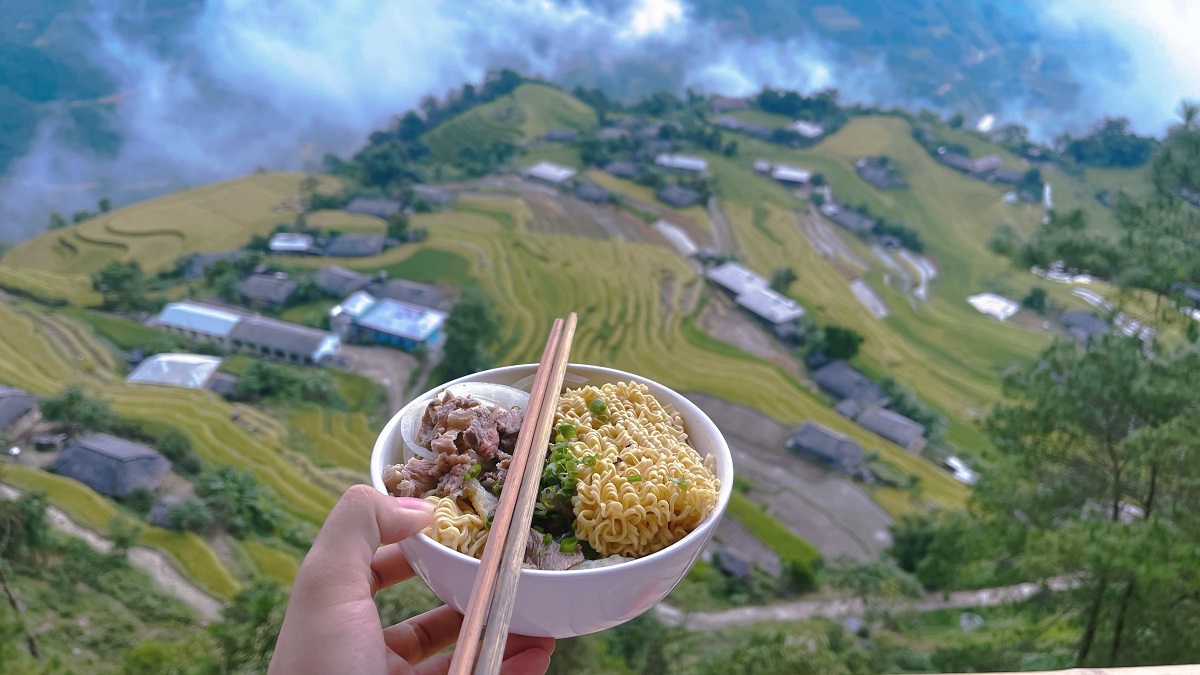
1. What Makes Hoang Su Phi Unique?
Unlike Vietnam’s more accessible rice terrace destinations, Hoang Su Phi offers a rare combination of pristine landscapes and cultural immersion that feels largely untouched by mass tourism. The district stretches across a remote mountainous region where the boundaries between Vietnam and China blur into misty peaks. Here, nature and human ingenuity have collaborated for generations to create living masterpieces that change with the seasons.
1.1 Terraced Rice Fields History & Culture
The terraced fields of Hoang Su Phi represent a 300-year-old agricultural tradition that transforms entire mountainsides into productive farmland. Local ethnic communities, primarily the Dao, Nung, and H’mong people, have hand-carved these terraces into steep slopes at elevations between 1,000 and 1,600 meters. They built elaborate irrigation systems that direct mountain streams through bamboo pipes and channels, ensuring water flows from the highest terrace to the lowest. This remarkable feat of engineering without modern technology earned Hoang Su Phi’s rice terraces National Heritage status in 2012.
The fields follow a traditional cultivation calendar that has remained largely unchanged for generations. During our visits to the region, local farmers have shared how planting typically begins in May with the first monsoon rains. They transplant young rice seedlings by hand into flooded terraces, creating the brilliant green landscapes that photographers chase. By September and October, as harvest approaches, the mountains transform into ribbons of gold that shimmer in the autumn light.
1.2 Ethnic Minorities and Local Life
Hoang Su Phi is home to at least ten distinct ethnic groups, each maintaining their unique cultural identity through language, dress, architecture, and traditions. The H’mong people, recognizable by their indigo-dyed clothes and silver jewelry, typically live in the highest villages. Dao women are known for their elaborate embroidery and distinctive red headscarves, while the Nung have mastered the art of crafting houses from natural materials that blend perfectly into the landscape.
Daily life in these communities revolves around agriculture, with families rising before dawn to tend fields and livestock. The villages pulse with activity women weaving textiles on traditional looms, men forging tools in small workshops, and children helping with household chores after school. During Phieu Travel’s guided tours, we’ve found that one of the most meaningful experiences for visitors is participating in community activities, whether joining a family meal or helping harvest rice during the golden season.
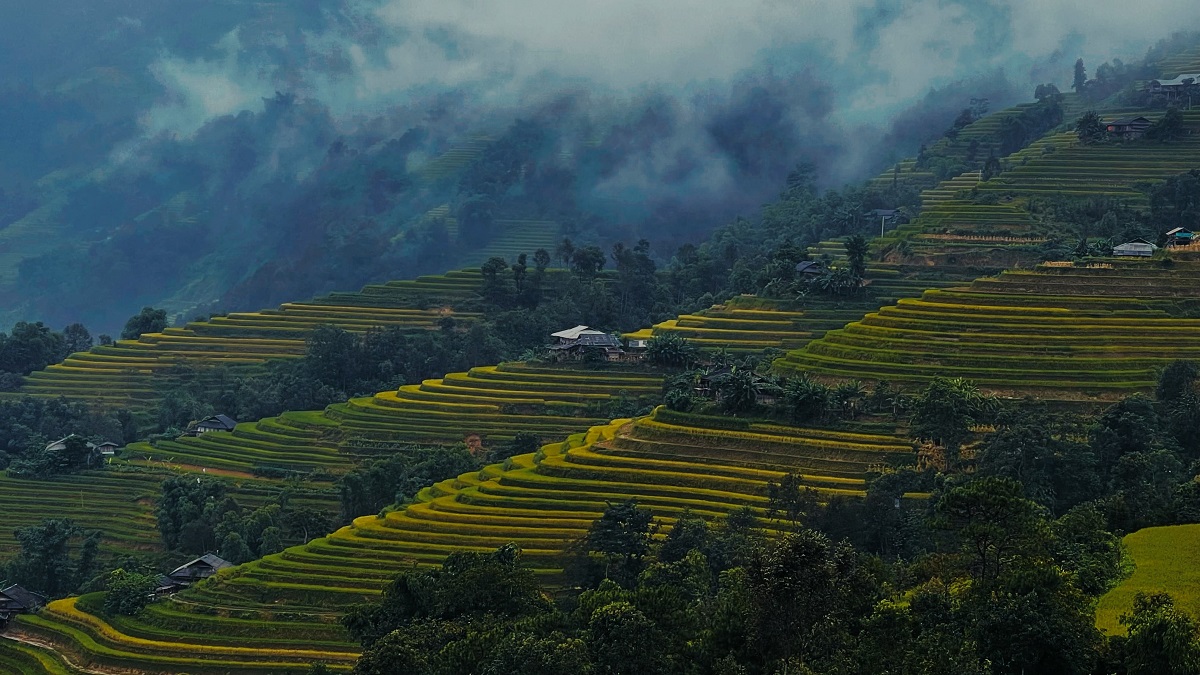
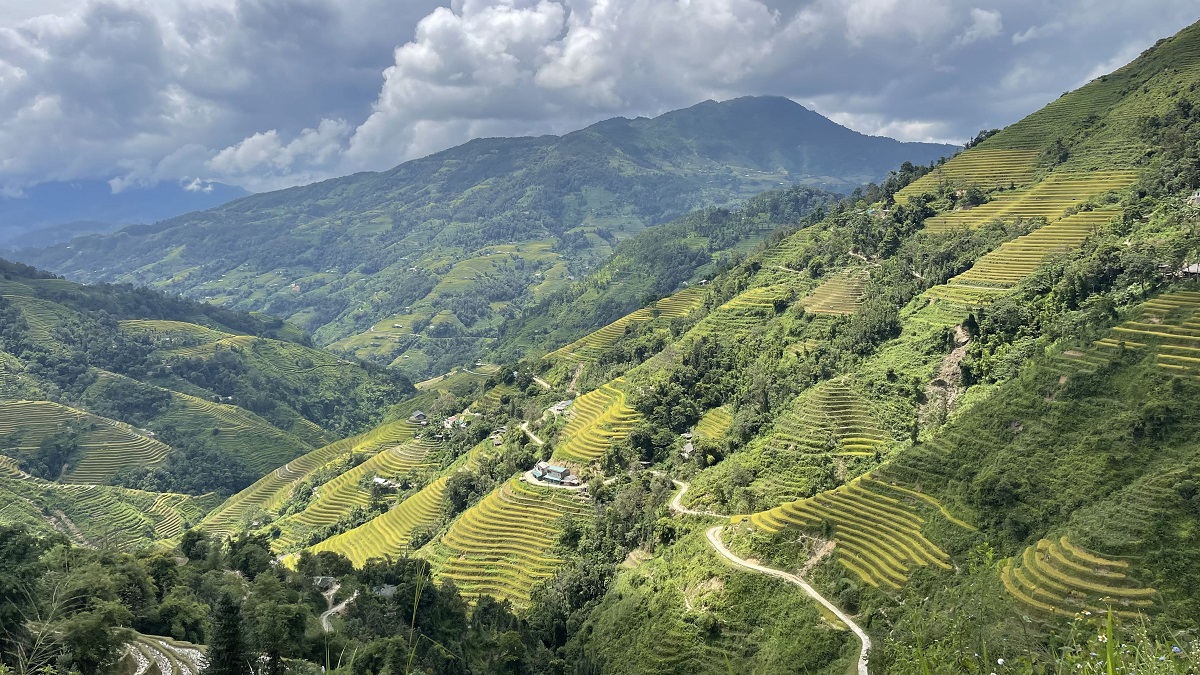
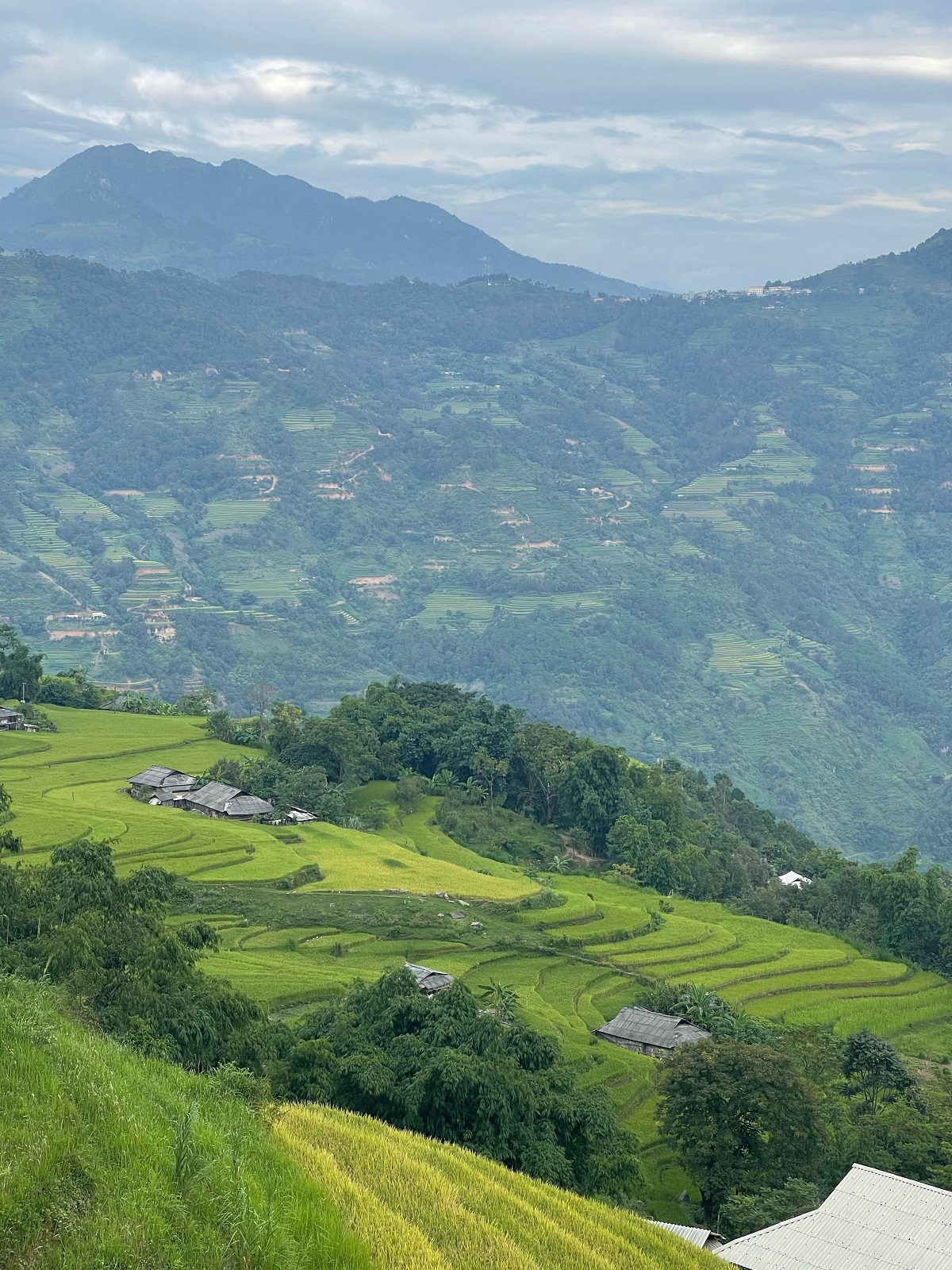
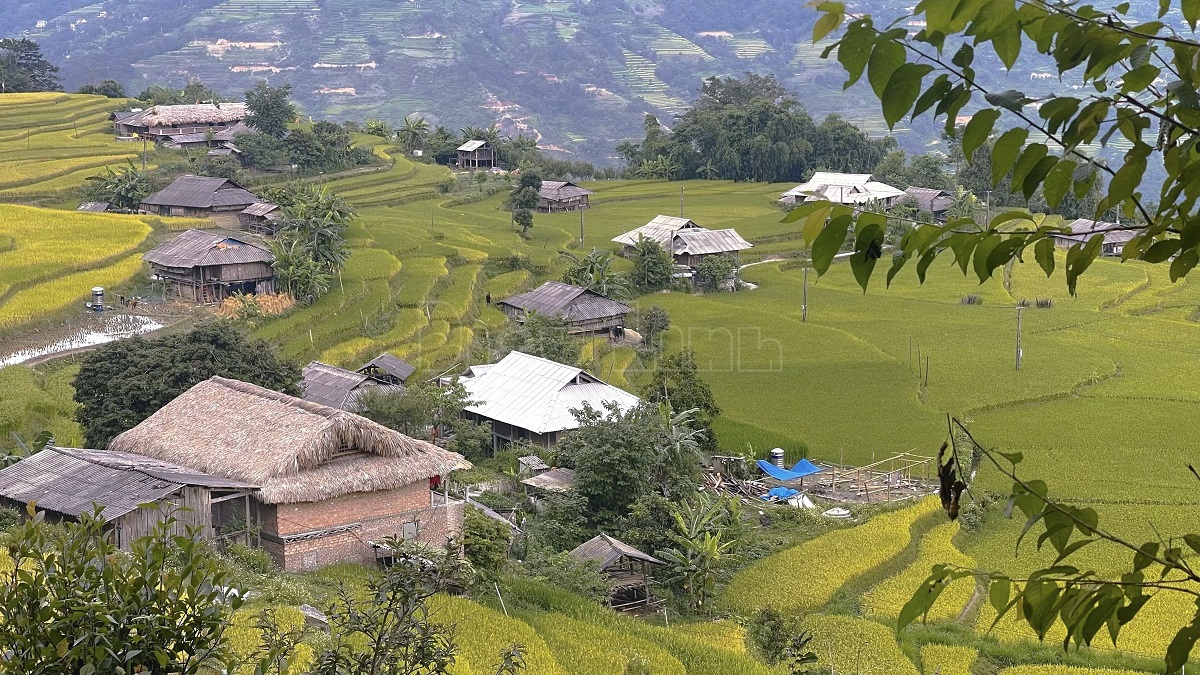
The Ultimate HaGiang Loop Guide (2025): Itinerary, Map & Tips
2. Best Time to Visit & Seasonal Calendar
Timing your visit to Hoang Su Phi is crucial, as the landscape transforms dramatically throughout the year. Each season offers a distinct experience and photographic opportunity, though some periods bring challenging weather conditions that travelers should consider carefully.
2.1 Rice Terrace Seasons Explained
The most spectacular time to visit Hoang Su Phi is during two key periods that showcase the rice terraces at their most photogenic:
Water Season (May to July): This period begins when farmers flood the terraces to prepare for planting. The mountains appear to be draped in thousands of mirrors reflecting the sky. By June and early July, newly planted rice turns the landscape into a patchwork of vibrant green hues. Early morning mist often settles between the mountains, creating dreamlike scenes as sunlight filters through.
Golden Season (September to early October): As rice matures, the terraces transform into waves of gold rippling across the mountains. This brief window typically only 2-3 weeks is the most sought-after time for photographers. The exact timing varies slightly each year depending on weather patterns, so at Phieu Travel, we monitor local reports closely to guide travelers to the perfect viewing time.
Winter months (November to February) bring dry, clear days but dormant brown terraces. Spring (March to April) sees farmers preparing fields, with some terraces showing early stages of cultivation. These seasons offer fewer crowds but less dramatic landscapes.

2.2 Key Festivals and Events
Timing your visit to coincide with local festivals provides deeper cultural immersion. Notable celebrations include:
- Long Tong Festival (January-February): A spring celebration where Tay communities pray for good harvests through traditional games, folk songs, and communal meals.
- Gau Tao Festival (February-March): A significant H’mong celebration featuring colorful costumes, traditional music, and courtship rituals.
- New Rice Festival (October): Held after harvest, communities gather to taste the first rice of the season and express gratitude through ceremonies and feasting.
- Lunar New Year/Tet (January-February): The biggest holiday of the year brings vibrant celebrations across all communities, with unique ethnic variations on traditional customs.
These events offer genuine cultural experiences but require advance planning. Local accommodations fill quickly, and some villages may have limited access during important ceremonies.

The Best Time to Visit Ha Giang: A Seasonal Guide to Flowers & Festivals
3. How to Get to Hoang Su Phi
Reaching Hoang Su Phi requires dedication, as its remote location is both its challenge and its charm. The journey itself becomes part of the adventure, taking travelers through some of northern Vietnam’s most spectacular mountain scenery.
3.1 Routes from Hanoi, Sapa, Ha Giang
Hoang Su Phi is famous for its breathtaking rice terraces, among the most beautiful in Ha Giang. The journey to this remote destination takes time, so choosing the right route and transport option can make your trip much smoother. Here are the main ways to get there:
From Hanoi
The distance from Hanoi to Hoang Su Phi is about 250 km, with a travel time of 7–8 hours. You can choose from:
-
Public bus: Depart from My Dinh Bus Station to Ha Giang City (around 6–7 hours), then continue by local bus or private car to Hoang Su Phi (about 2 hours).
-
Private car or guided tour: Services like Phieu Travel provide flexibility, allowing scenic stops along the way for photos and breaks.
-
Direct sleeper bus: Some companies offer overnight buses straight to Hoang Su Phi, but departures are limited to 1–2 per day, so booking in advance is recommended.
From Sapa
The route from Sapa to Hoang Su Phi covers about 160 km and takes 5–6 hours on winding mountain roads.
-
Public minivans operate between Sapa and Hoang Su Phi, though schedules can be irregular.
-
Private transport is the most reliable and comfortable choice, especially if you’re traveling in a group.
From Ha Giang City
Ha Giang City is the most common starting point for a Hoang Su Phi trip. The distance is about 70 km, which takes roughly 2 hours by car or motorbike.
-
Daily buses run from Ha Giang Bus Station to Hoang Su Phi town, usually departing in the morning.
-
Private car or motorbike rental gives you more freedom to explore the scenic route.
3.2 Motorbike vs. Bus vs. Private Car: Pros & Cons
When planning your trip to Hoang Su Phi, choosing the right mode of transport can make all the difference. Each option motorbike, public bus, or private car offers its own advantages and trade-offs. Here’s a breakdown to help you decide:
Motorbike Rental
- Pros: Ultimate flexibility to stop at viewpoints; access to remote villages; exhilarating mountain driving.
- Cons: Physically demanding; challenging roads for inexperienced riders; weather exposure; limited luggage capacity.
- Cost: $10-15/day for standard bikes; $20-25/day for larger models.
Public Bus
- Pros: Inexpensive ($5-8 for most routes); chance to travel with locals; reduced environmental impact.
- Cons: Fixed schedules with limited departures; basic comfort; restricted to main roads; communication challenges.
- Note: Buses typically arrive at Hoang Su Phi town center, requiring additional transport to reach specific villages.
Private Car/Driver
- Pros: Comfort; flexibility; ability to reach viewpoints off main roads; shelter during bad weather; luggage space.
- Cons: Higher cost ($80-120/day depending on vehicle); less immersive than motorbike travel.
Through Phieu Travel’s experience guiding visitors through this region, we recommend private transport for families or those with limited time. For adventurous travelers with 3+ days to explore, motorbikes offer unmatched freedom to discover hidden corners of the district. Those on tighter budgets can combine public buses with local motorbike taxis (xe om) for the final leg to specific villages.
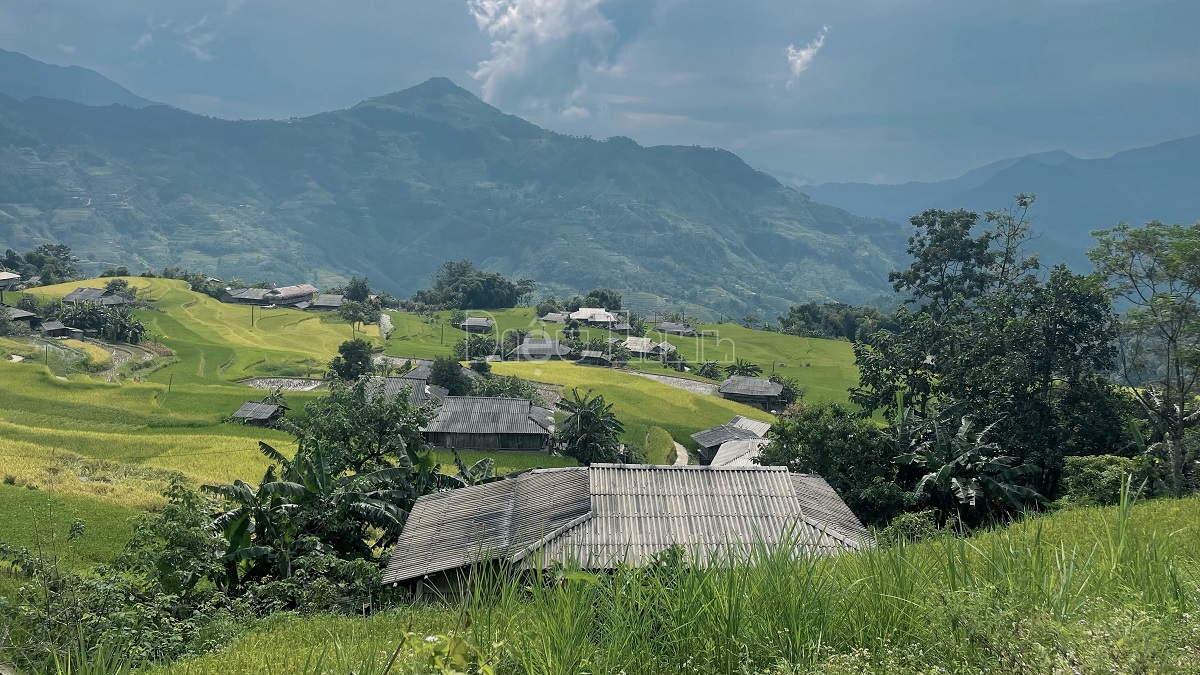
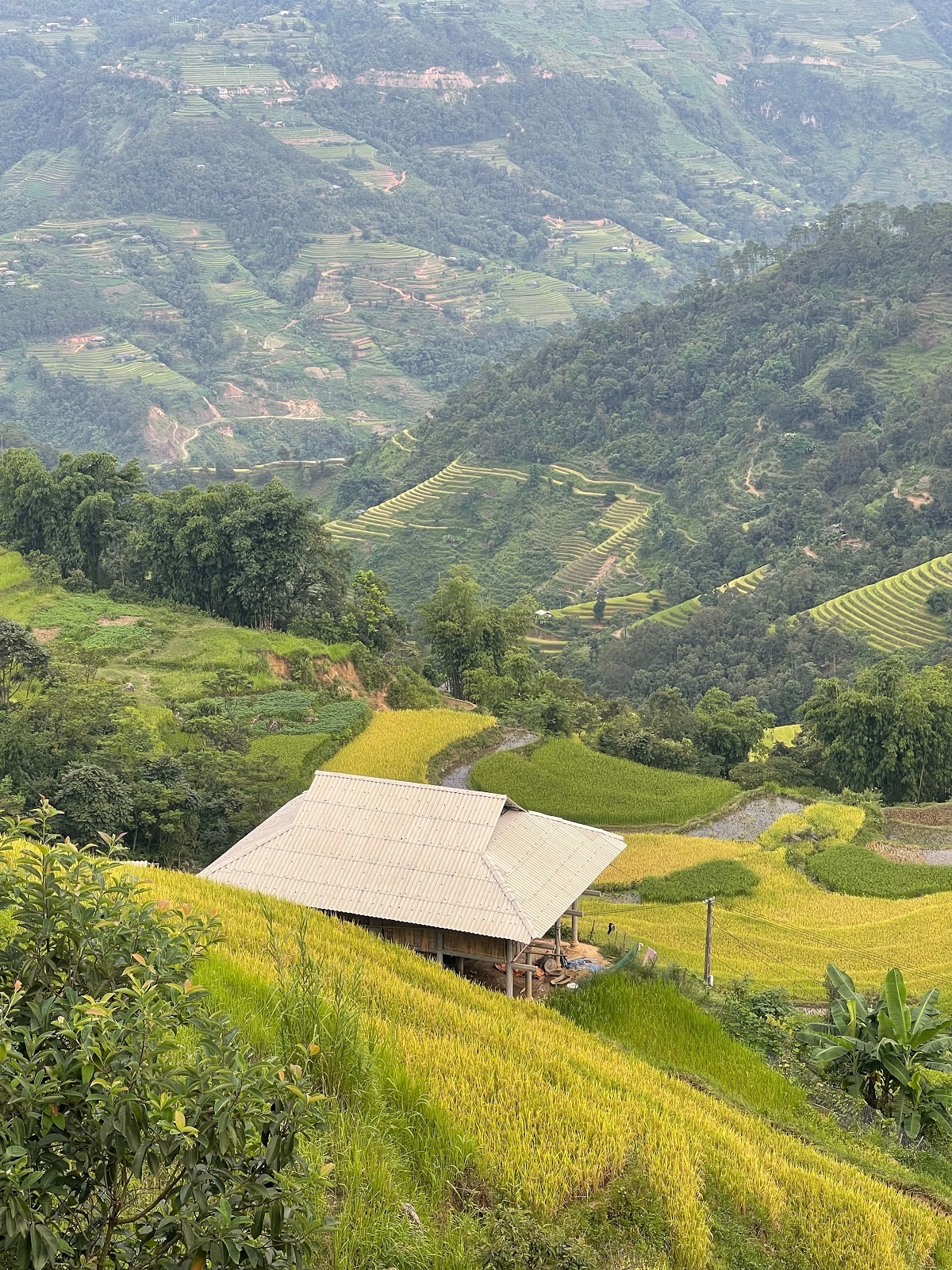

Ha Giang Loop cost guide 2025: real prices, tour options & savings
4. Top 5 Rice Terrace Villages to Explore
Hoang Su Phi district encompasses several communes, each with distinctive terrace configurations and cultural characteristics. Based on our extensive exploration of the region, these five villages offer the most rewarding experiences for visitors.
4.1 Ban Phung
Widely considered to showcase Hoang Su Phi’s most photogenic terraces, Ban Phung commune sits at elevations between 800-1,200 meters. The rice fields here are arranged in perfect concentric patterns that ripple down mountainsides like giant fingerprints. What makes these terraces especially dramatic is their steepness some sections appear to cascade almost vertically down the slopes.
The village itself is predominantly Red Dao, with women wearing distinctive red headscarves and elaborate embroidered clothing. Many families open their traditional wooden houses to visitors, offering homestay experiences that provide authentic insight into daily life. From Ban Phung’s higher viewpoints, particularly at sunrise, photographers can capture terraces emerging from the morning mist a scene that has graced numerous international travel publications.
4.2 Nam Ty
Nam Ty commune offers some of the district’s most extensive and accessible terraced landscapes. The terraces here spread across wide valleys before climbing steep mountains, creating mesmerizing patterns visible from multiple vantage points. What distinguishes Nam Ty is the remarkable engineering of its water management system intricate channels and bamboo aqueducts direct mountain streams across vast distances.
The area is home to both Dao and Nung communities, creating a rich cultural tapestry. During our guided tours, we often stop at the impressive Nam Ty suspension bridge, which offers dramatic views of the terraces from mid-valley. The village market, held every Sunday morning, provides an excellent opportunity to interact with local farmers and artisans selling traditional crafts and produce.
4.3 Thong Nguyen
Thong Nguyen commune is renowned for its spectacular golden harvest scenes each autumn. The terraces here feature particularly wide steps that create bold geometric patterns across the hillsides. Unlike some more vertical terraces elsewhere, Thong Nguyen’s formations allow easier access for farming and for visitors wanting to walk among the fields.
The commune is predominantly inhabited by Tay people, who typically build stilted wooden houses along valley floors and lower slopes. The combination of these traditional homes with towering terraced mountains creates perfect photographic compositions. Thong Nguyen is also home to several community-based tourism initiatives where locals offer guided hikes through the terraces, explaining cultivation techniques and cultural significance.
4.4 Ban Luoc
Ban Luoc stands out for its remote location and relatively untouched character. The journey here requires traversing some of the district’s most challenging roads, but rewards travelers with pristine landscapes and authentic cultural encounters. The terraces in Ban Luoc are notable for their incredible height, stretching from valley floors to mountain peaks in seemingly endless tiers.
Predominantly H’mong villages dot the higher elevations, while Nung communities occupy the lower valleys. During Phieu Travel’s visits here, we’ve witnessed traditional agricultural techniques rarely seen elsewhere, including water buffalo-powered plowing and hand harvesting with simple tools. The village’s isolation has preserved many cultural practices, making it an anthropological treasure as well as a scenic wonder.
4.5 Ho Thau
Ho Thau commune offers perhaps the most diverse terraced landscapes in Hoang Su Phi. Its varied elevation and topography create a stunning variety of terrace formations from tight, narrow steps on steeper slopes to expansive, sweeping terraces along gentler gradients. The western-facing orientation of many terraces makes this area particularly spectacular at sunset, when golden light washes across the rice fields.
The commune is home to a fascinating mix of ethnic groups, including La Chi people who are rarely encountered elsewhere in the region. Their distinctive agricultural knowledge has shaped unique terrace designs adapted to local soil and water conditions. Ho Thau also features several beautiful mountain streams and small waterfalls that enhance the landscape’s photogenic quality, especially during the rainy season.
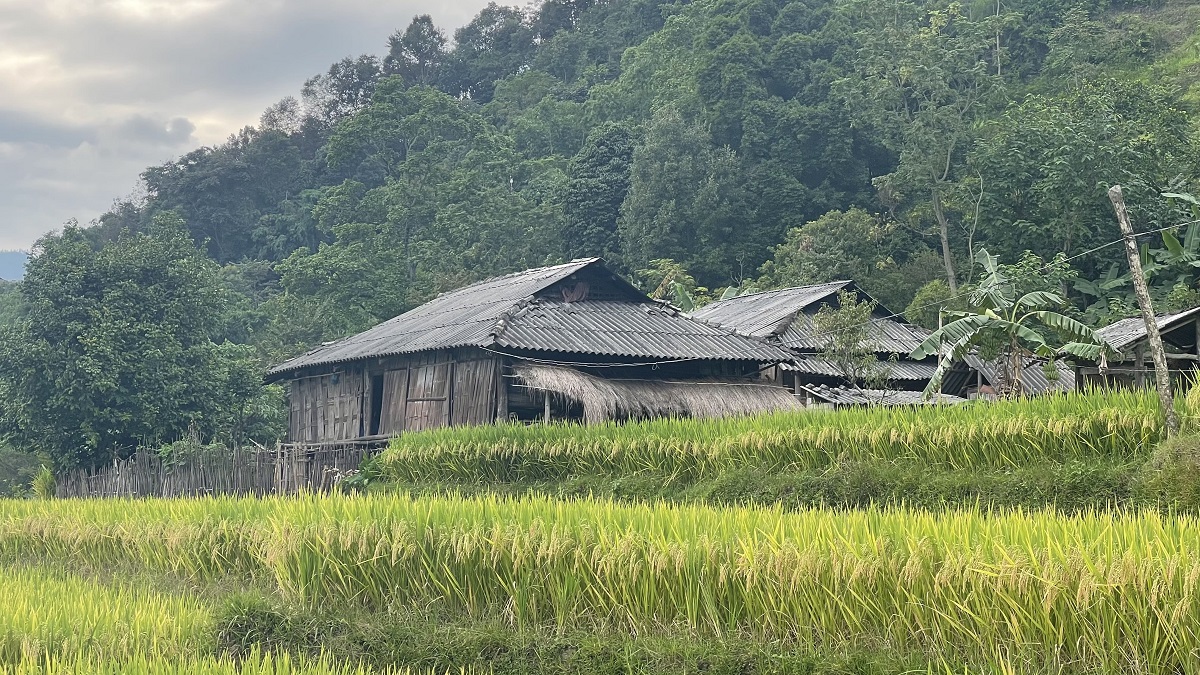
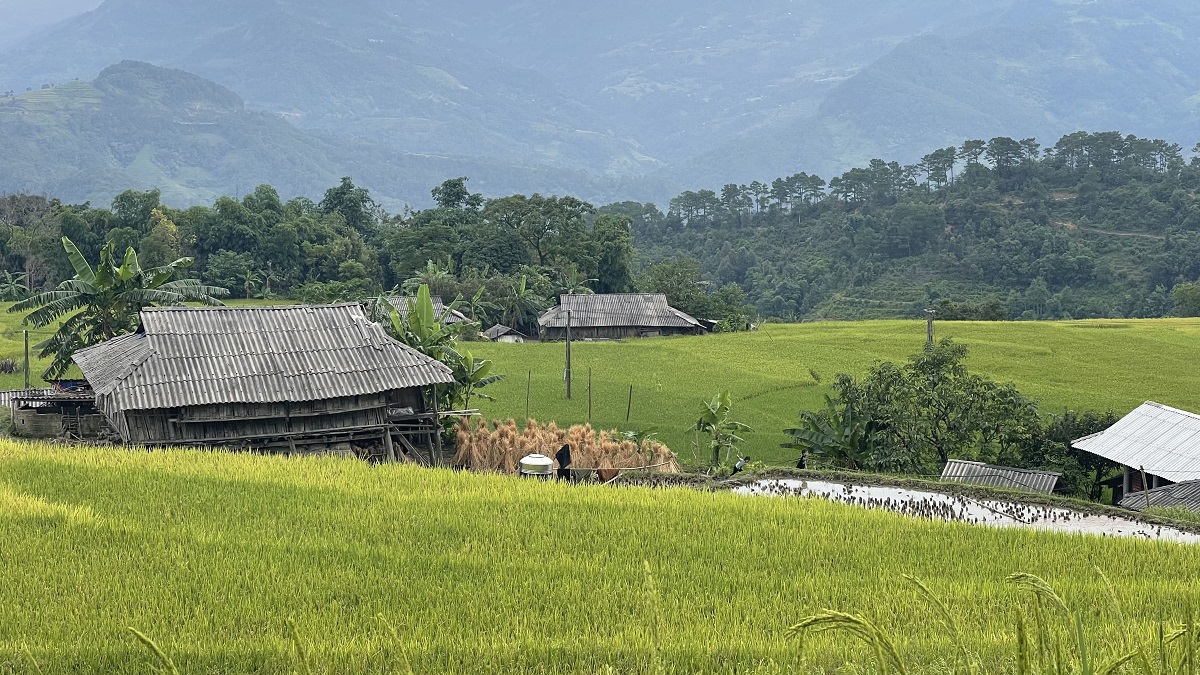
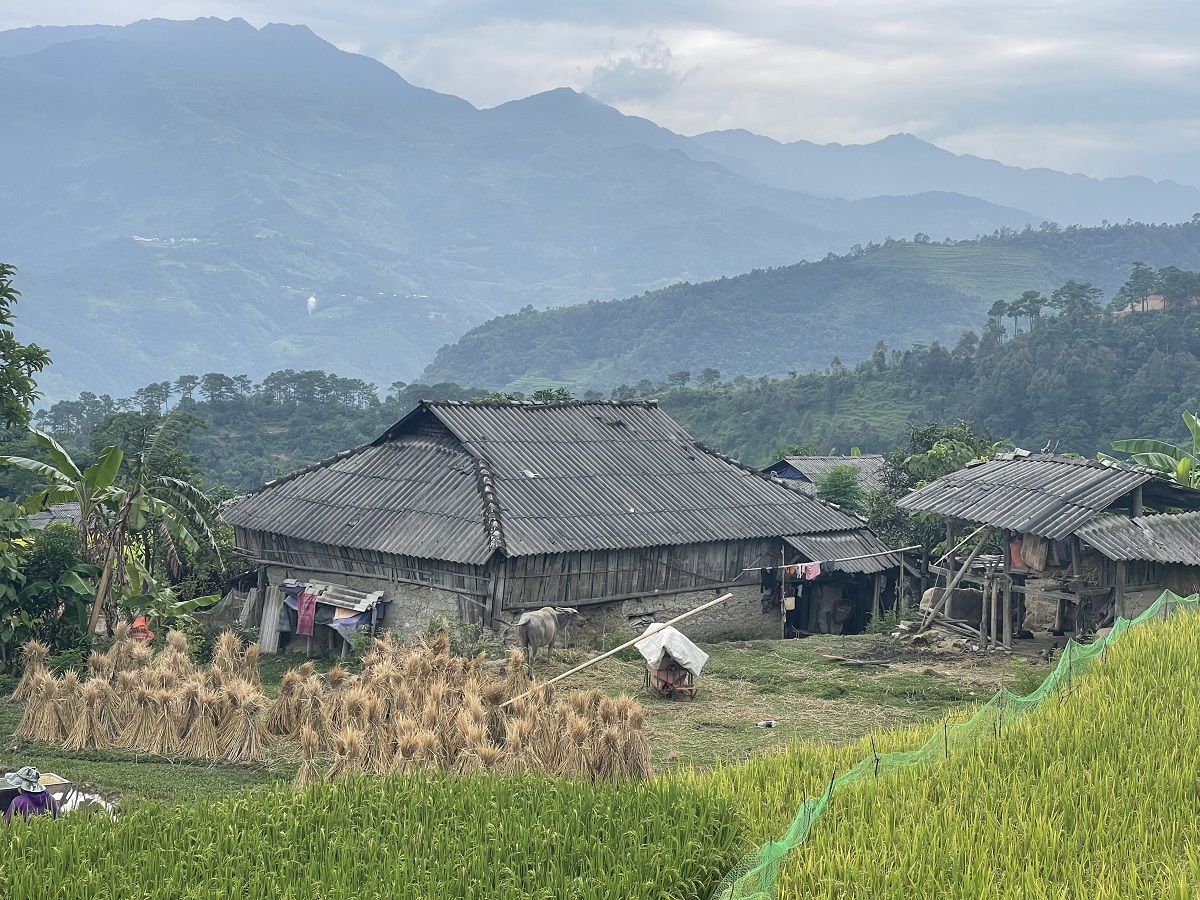

Ha Giang weather by month complete local guide for travelers
5. Where to Stay: Best Homestays and Eco-Lodges
Accommodations in Hoang Su Phi have evolved significantly in recent years, balancing authentic cultural experiences with sufficient comfort for travelers. Options range from basic homestays in traditional ethnic minority houses to more developed eco-lodges with enhanced amenities.
5.1 What to Expect (Facilities, Culture, Booking)
Traditional Homestays offer the most immersive cultural experience. Typically, these are family homes that welcome guests to sleep in communal areas or dedicated guest rooms. Facilities usually include:
- Shared sleeping spaces on mattresses or mats, often with mosquito nets.
- Simple bathroom facilities, sometimes detached from the main house.
- Home-cooked meals featuring local ingredients and traditional recipes.
- Opportunities to participate in family activities and agricultural tasks.
Prices range from $10-15 per person, including meals. Most operate on a cash basis, and while some can be booked online through Phieu Travel, many require advance arrangement through local contacts.
Community-Based Tourism (CBT) Homestays represent a middle ground, with slightly enhanced facilities while maintaining cultural authenticity. These houses have been modified specifically for tourism purposes and typically offer:
- Private or semi-private sleeping areas with proper beds.
- Attached bathrooms with Western toilets and hot water.
- Structured cultural activities like cooking classes or craft demonstrations.
- English-speaking hosts or community guides.
Prices typically range from $15-25 per person including meals and some activities. Several established CBT networks operate in villages like Ban Phung and Thong Nguyen, with central booking systems that can be arranged online.
Eco-Lodges and Boutique Accommodations have emerged in strategic locations offering premium experiences with minimal environmental impact. These properties feature:
- Private bungalows or rooms with comfortable bedding and furnishings.
- Modern bathrooms with reliable hot water and Western amenities.
- Restaurant facilities serving both local and international cuisines.
- Organized excursions with professional guides.
- Spectacular views of terraced fields from elevated positions.
Prices range from $40-100 per night depending on the season and facilities. Advanced booking is essential, especially during harvest season when demand far exceeds capacity.
During peak periods (September-October), all accommodation types fill quickly. Based on our experience arranging thousands of trips through Phieu Travel, we recommend booking at least 2-3 months in advance for golden season visits.
5.2 Sample Itineraries (1–5 days)
Based on our experience guiding travelers through Hoang Su Phi, we’ve developed these time-optimized itineraries:
1-Day Express Visit (ideal as a side trip from Ha Giang)
- Morning: Depart Ha Giang early, drive directly to Ban Phung viewpoint
- Midday: Lunch at a local home, short guided walk through terraces
- Afternoon: Visit Nam Ty bridge viewpoint, return to Ha Giang by evening
2-Day Essential Experience
- Day 1: Morning departure from Ha Giang, visit Ban Phung terraces, afternoon hike through fields, overnight in local homestay
- Day 2: Sunrise photography, visit Thong Nguyen commune, lunch with local family, return to Ha Giang
3-Day Immersion
- Day 1: Travel from Ha Giang to Ban Phung, afternoon exploration of village and fields, cultural dinner and overnight in homestay
- Day 2: Morning hike through terraces, transfer to Thong Nguyen, visit local craft workshops, overnight in eco-lodge
- Day 3: Sunrise photography, visit Ho Thau commune, lunch with local family, return to Ha Giang
5-Day Complete Experience
- Day 1: Travel from Hanoi to Ha Giang, overnight in town
- Day 2: Journey to Ban Phung, afternoon exploration, cultural immersion activities
- Day 3: Hiking through Ban Luoc’s remote terraces, interaction with farmers
- Day 4: Visit Nam Ty market (if Sunday), explore water systems and viewpoints
- Day 5: Morning in Ho Thau commune, afternoon return to Ha Giang or continue to other destinations
These itineraries can be customized based on physical ability, special interests, and seasonal conditions. Through Phieu Travel, travelers can arrange private guides who speak both English and local ethnic languages, providing deeper cultural context and access to less-visited areas.
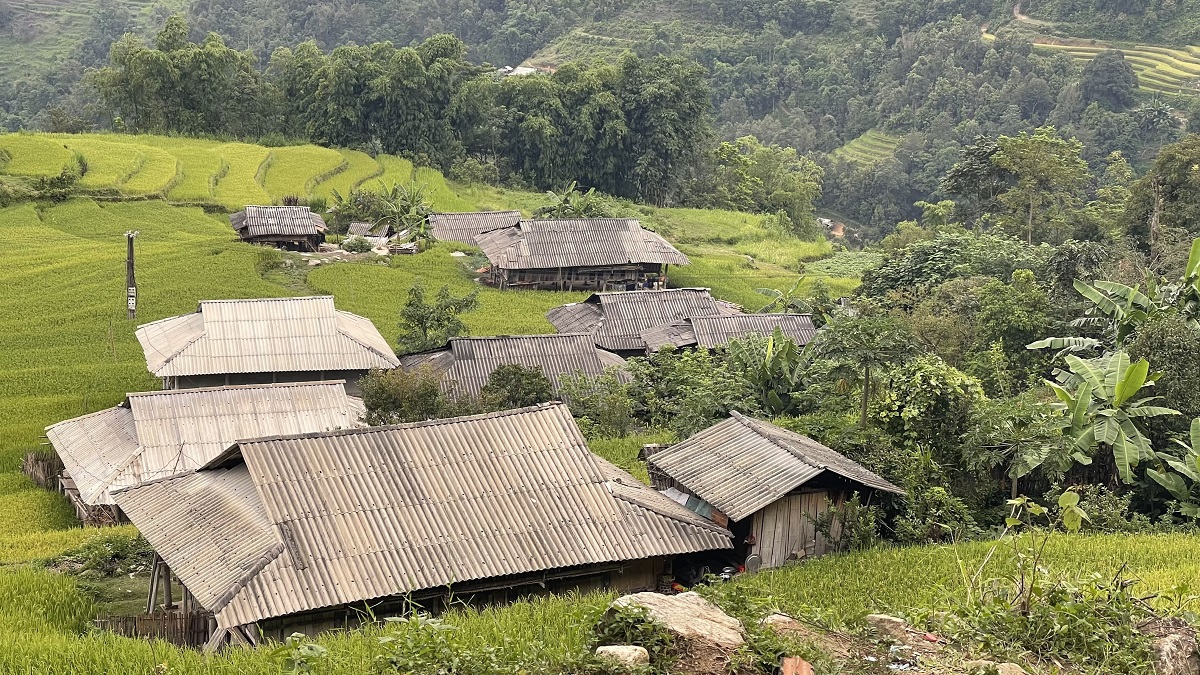
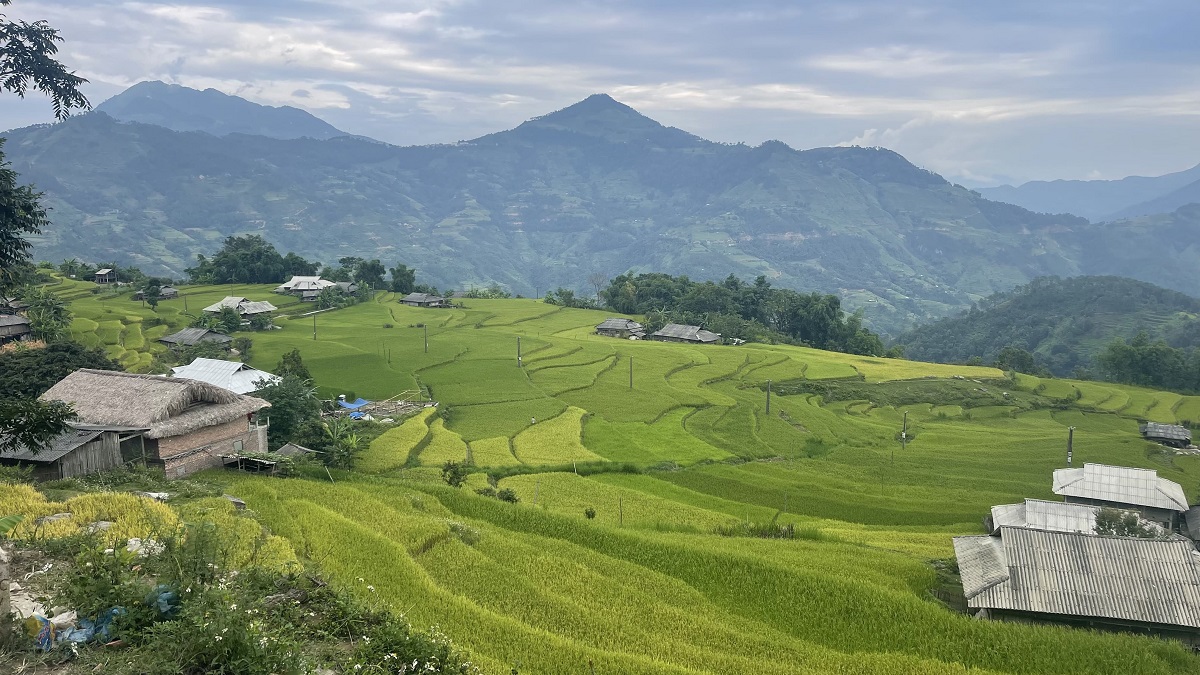
6. Essential Tips for Trekking & Local Etiquette
Exploring Hoang Su Phi respectfully requires preparation and cultural awareness. The remote nature of the region presents both challenges and opportunities for meaningful engagement with landscapes and communities.
6.1 Trekking Difficulty and Preparation
Trekking in Hoang Su Phi ranges from gentle walks along established paths to challenging hikes across steep terrain. We categorize routes into three difficulty levels:
Easy Trails: Accessible pathways near main villages, typically 1-3 hours duration. These follow established routes between terraces and require only basic fitness. Suitable for most visitors, including families with children and seniors in reasonable health.
Moderate Treks: Half-day routes that connect villages or reach elevated viewpoints. These involve some steep sections and uneven terrain, requiring decent fitness and proper footwear. Most physically active travelers can manage these with occasional rest stops.
Challenging Hikes: Full-day journeys reaching remote terraces or mountain ridges. These demanding routes involve sustained climbing, occasionally slippery paths, and limited facilities along the way. Recommended only for experienced hikers with appropriate gear.
Essential gear for any trekking in Hoang Su Phi includes:
- Sturdy, waterproof hiking shoes with good traction.
- Lightweight, quick-dry clothing (layers are best for variable mountain weather).
- Rain protection (even in dry season, mountain showers occur).
- Sun protection (hat, sunscreen, sunglasses).
- Water purification options (limited clean water sources on longer treks).
- Basic first aid supplies (pharmacies are scarce outside district centers).
- Camera with weather protection and spare batteries.
During rice planting and harvest seasons, paths through terraces can become extremely muddy. Many Phieu Travel clients find trekking poles invaluable for stability, especially on steeper descents.
6.2 Responsible Tourism & Cultural Respect
Hoang Su Phi’s communities maintain traditional lifestyles that deserve thoughtful consideration from visitors. Based on our long experience in the region, we recommend these guidelines:
- Ask before photographing people. While many locals are accustomed to tourism, direct portrait photography should always follow explicit permission, especially with elderly community members.
- Dress modestly when visiting villages. Conservative clothing that covers shoulders and knees shows respect for local customs and reduces unwanted attention.
- Remove shoes when entering homes. Traditional houses have specific protocols about indoor footwear, which your host or guide can explain.
- Accept offered hospitality graciously. If invited for tea or food, accepting even a small amount acknowledges the importance of sharing in local culture.
- Learn basic greetings in local languages. Even simple phrases demonstrate respect and create meaningful connections.
- Support local economies directly. Purchase handcrafts from artisans, use community-based services, and ensure fair compensation for guides and hosts.
- Minimize environmental impact. Carry out all trash, avoid single-use plastics, and stay on established paths to prevent erosion of fragile terraces.
These practices not only show respect but enhance your own experience by fostering genuine cultural exchange rather than superficial observation.
6.3 Safety and Packing List
Hoang Su Phi’s remote location means travelers must be self-sufficient and prepared for changing conditions. Our essential packing recommendations include:
Clothing:
- Quick-dry, breathable layers.
- Lightweight rain jacket or poncho.
- Warm layer for cool evenings (even in summer).
- Sturdy walking shoes plus sandals for evenings.
- Hat for sun protection.
Health & Safety:
- Personal medications (bring extra).
- Basic first aid kit with blister treatment.
- Insect repellent (particularly important during summer).
- Stomach remedies for unfamiliar foods.
- Rehydration sachets.
- Flashlight or headlamp (power outages occur).
Practical Items:
- Power bank (charging opportunities are limited).
- Universal adapter.
- Small daypack for trekking.
- Reusable water bottle.
- Wet wipes and hand sanitizer.
- Cash in small denominations (ATMs are rare).
For Photographers:
- Extra batteries and memory cards.
- Lens cleaning supplies (dusty conditions are common).
- Lightweight tripod for low-light conditions.
- Protective rain cover.
Weather conditions can change rapidly in mountain environments. The road to Hoang Su Phi occasionally experiences landslides during heavy rains, potentially causing travel delays. Working with experienced guides from Phieu Travel ensures you’ll have local knowledge to navigate these challenges safely.
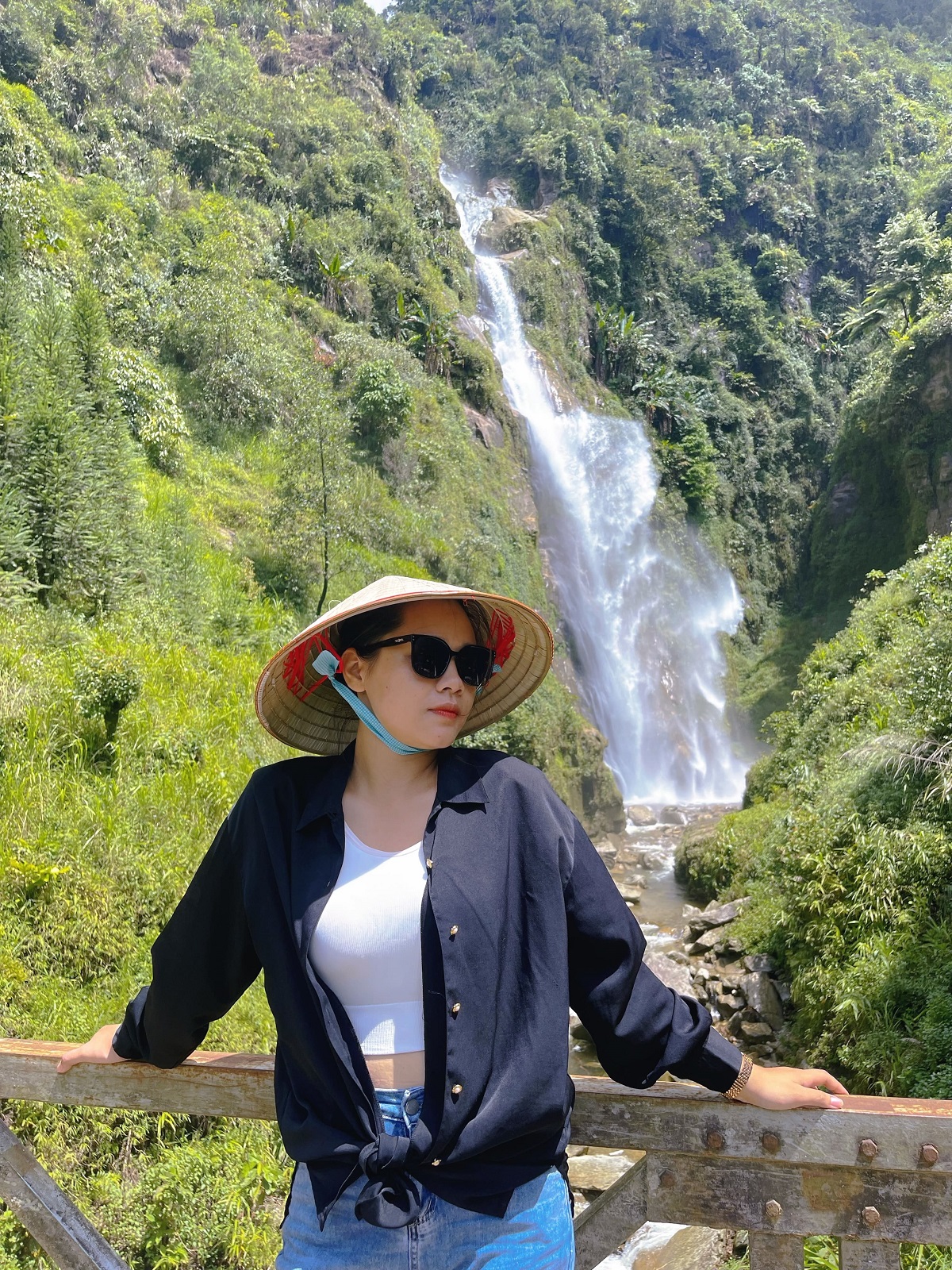
Hoang Su Phi offers a rare glimpse into a Vietnam that exists beyond the familiar tourist circuit a place where ancient agricultural practices shape breathtaking landscapes and ethnic cultures maintain their distinctive identities. As travelers ourselves, we at Phieu Travel believe this remote corner of Ha Giang province provides some of Southeast Asia’s most authentic and photogenic experiences. The journey requires effort, flexibility, and cultural sensitivity, but rewards visitors with unforgettable vistas and genuine human connections. Whether you’re photographing golden terraces at harvest time or sharing a meal with a Red Dao family, Hoang Su Phi inspires a deeper appreciation for the harmony between human ingenuity and natural beauty. For personalized journey planning to Hoang Su Phi and other hidden gems across Vietnam, visit us at Phieutravel.com.
Read more:
- Best places to visit in Northern Vietnam a complete 2025 guide
- Ha Giang Loop in December best weather for epic adventure
- Ha Giang Trekking Tours: Ultimate Guide for Adventurers 2025
- How to get a visa for Vietnam complete 2025 guide

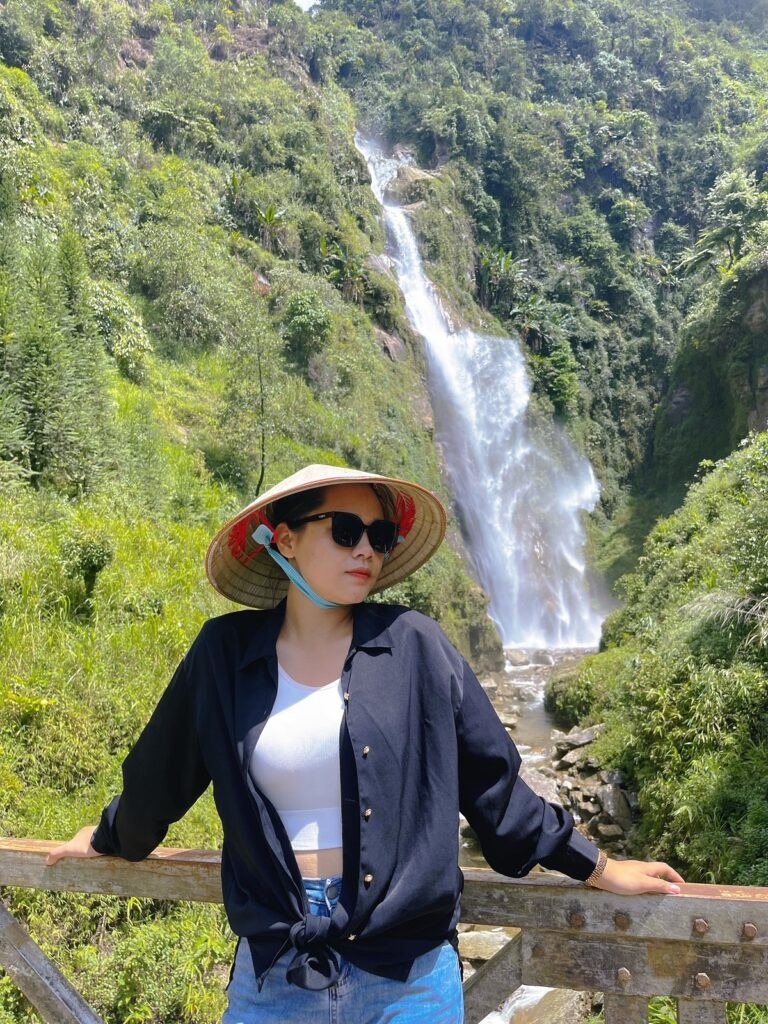
You Might Also Like
Ha Giang Weather in September: Complete Guide for Travelers
Exploring the magnificent Ha Giang Loop in September offers travelers a perfect balance of favorable[...]
Quan Ba Twin Mountains: Ha Giang’s Iconic Fairy Hills and Complete Travel Guide
The mystical Quan Ba Twin Mountains rise from the emerald valleys of Ha Giang like[...]
Vuong family mansion: the architectural marvel and cultural legacy of Ha Giang
Deep in Vietnam’s northern highlands, where mist-shrouded mountains meet terraced rice fields, stands a testament[...]
Ha Giang Loop Safety Tips: How to Ride Securely in Vietnam’s Northern Mountains
The Ha Giang Loop, with its winding mountain roads and breathtaking landscapes, offers one of[...]
The Ultimate Guide to the M-Shaped Curve on Ha Giang Loop
Vietnam’s remote northern province of Ha Giang hides a natural wonder that has captivated adventurous[...]
Most Beautiful Places to Visit in Vietnam: Essential Destinations and Insider Tips
Vietnam captivates travelers with its stunning landscapes, rich cultural heritage, and warm hospitality. From mist-shrouded[...]
Beyond the Beaten Path: Discovering Ha Giang Province in Northeast Vietnam
Ha Giang Province in Northeast Vietnam stands as one of the country’s last frontiers for[...]
Rainy season in Ha Giang: what to expect, when to go, and travel tips
Vietnam’s northern frontier reveals a different face during the rainy season, transforming Ha Giang’s limestone[...]